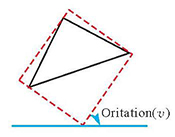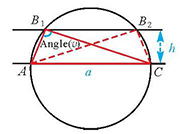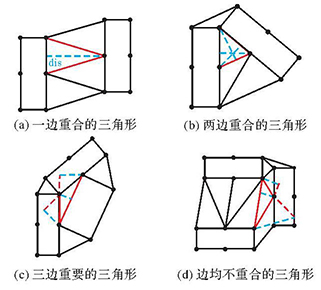



Acta Geodaetica et Cartographica Sinica ›› 2024, Vol. 53 ›› Issue (4): 736-749.doi: 10.11947/j.AGCS.2024.20230316
• Cartography and Geoinformation • Previous Articles Next Articles
Zhanlong CHEN1,2,3( ), Xiechun LU1(
), Xiechun LU1( ), Yongyang XU2,3
), Yongyang XU2,3
Received:2023-08-07
Revised:2024-02-04
Published:2024-05-13
Contact:
Xiechun LU
E-mail:chenzl@cug.edu.cn;xiechunlu@cug.edu.cn
About author:CHEN Zhanlong (1980—), male, PhD, professor, majors in spatial analysis algorithms, spatial reasoning, geographic information system software and application development. E-mail: chenzl@cug.edu.cn
Supported by:CLC Number:
Zhanlong CHEN, Xiechun LU, Yongyang XU. A building aggregation method based on deep clustering of graph vertices[J]. Acta Geodaetica et Cartographica Sinica, 2024, 53(4): 736-749.
Tab. 1
Triangle parameters calculation"
| 参量名称 | 计算方法 | 示意图 |
|---|---|---|
| 面积Area(v) | 描述三角形大小的参量,通常使用公式Area(v)=1/2a×h计算 |  |
| 最小外接矩形方向Oritation(v) | 三角形最小接矩形在二维平面中的朝向,此处计算为朝向与x轴的夹角,Oritation(v)∈[0,1] |  |
| 三角形底与高的比值Ratio(v) | 三角形的形状可以由三角形底与高的比值,以及底边对角的角度唯一确定[ |  |
| 三角形底边对角的角度Angle(v) | 三角形最长边对角的角度(此处计算采用最长边作为底边),Angle(v)∈(0,π) | |
| 多比例尺综合约束距离Tolerant_Dis(v,δ) | 描述三角形形态与综合约束距离δ之间的参量。当三角形一边与建筑物原始轮廓重合时,记该边到对角的距离为dis,则Tolerant_Dis(v,δ)=e-max[(dis-δ),0];若三角形有多条边与建筑物轮廓重合,则三边高均小于δ(点加密距离小于等于δ情况下),因此Tolerant_Dis(v,δ)=1;若三角形每一条边均不与建筑物轮廓重合,则dis为三边高的均值 |  |
| 三角形之间的距离Distance(u,v) | 两三角形重心间的欧氏距离。(x1,y1)、(x2,y2)分别为两三角形重心坐标,Distan (u,  |  |
Tab. 4
Assessment indicator value changes before and after the aggregation"
| 合并方法 | δ/m | 建筑物数量 | 建筑物间最小距离/m | 建筑物轮廓长度/m | 不合理连接面数量 | 居民地数量变化率/(%) | 轮廓长度变化率/(%) | 不同阈值下合并结果相似性/(%) |
|---|---|---|---|---|---|---|---|---|
| 原始数据 | 119 | 0.85 | 9 395.3 | — | — | — | — | |
| 图顶点深度聚类 | 7.5 | 26 | 9.13 | 7 652.6 | 0 | 78.15 | 18.55 | 77.34 |
| 图顶点深度聚类 | 12.5 | 8 | 13.76 | 6 012.3 | 0 | 93.28 | 36.01 | |
| ArcGIS面聚合 | 7.5 | 31 | 7.63 | 7 927.3 | 3 | 73.95 | 15.62 | 76.32 |
| ArcGIS面聚合 | 12.5 | 9 | 13.12 | 6 087.5 | 2 | 92.44 | 35.21 |
| [1] | 武芳, 巩现勇, 杜佳威. 地图制图综合回顾与前望[J]. 测绘学报, 2017, 46(10):1645-1664.DOI: 10.11947/j.AGCS.2017.20170287. |
| WU Fang, GONG Xianyong, DU Jiawei. Overview of the research progress in automated map generalization[J]. Acta Geodaetica et Cartographica Sinica, 2017, 46(10):1645-1664.DOI: 10.11947/j.AGCS.2017.20170287. | |
| [2] | 王家耀, 武芳, 闫浩文. 大变化时代的地图学[J]. 测绘学报, 2022, 51(6):829-842.DOI: 10.11947/j.AGCS.2022.20210661. |
| WANG Jiayao, WU Fang, YAN Haowen. Cartography: its past, present and future[J]. Acta Geodaetica et Cartographica Sinica, 2022, 51(6):829-842. DOI: 10.11947/j.AGCS.2022.20210661. | |
| [3] | 高晓蓉, 闫浩文, 禄小敏. 多尺度地图空间居民地语义相似度计算方法[J]. 测绘学报, 2022, 51(1):95-103.DOI: 10.11947/j.AGCS.2022.20210074. |
| GAO Xiaorong, YAN Haowen, LU Xiaomin. Semantic similarity measurement for building polygon aggregation in multi-scale map space[J]. Acta Geodaetica et Cartographica Sinica, 2022, 51(1):95-103.DOI: 10.11947/j.AGCS.2022.20210074. | |
| [4] | 杨好, 何宗宜, 陈华洋, 等. 顾及路网结构保持的城镇居民地自动综合[J]. 武汉大学学报(信息科学版), 2018, 43(6):965-970. |
| YANG Hao, HE Zongyi, CHEN Huayang, et al. A method for automatic generalization of urban settlements considering road network[J]. Geomatics and Information Science of Wuhan University, 2018, 43(6):965-970. | |
| [5] | 武芳, 杜佳威, 钱海忠, 等. 地图综合智能化研究的发展与思考[J]. 武汉大学学报(信息科学版), 2022, 47(10):1675-1687. |
| WU Fang, DU Jiawei, QIAN Haizhong, et al. Overview of research progress and reflections in intelligent map generalization[J]. Geomatics and Information Science of Wuhan University, 2022, 47(10):1675-1687. | |
| [6] | 郭仁忠, 艾廷华. 制图综合中建筑物多边形的合并与化简[J]. 武汉测绘科技大学学报, 2000, 25(1):25-30. |
| GUO Renzhong, AI Tinghua. Simplification and aggregation of building polygon in automatic map generalization[J].Journal of Wuhan Technical University of Surveying and Mapping, 2000, 25(1):25-30. | |
| [7] | 王光霞, 杨培. 数学形态学在居民地街区合并中的应用[J]. 测绘学院学报, 2000, 17(3):201-203. |
| WANG Guangxia, YANG Pei. Application of mathematic morphology in uniting blocks of residential area[J]. Journal of Institute of Surveying and Mapping, 2000, 17(3):201-203. | |
| [8] | SHEN Yilang, AI Tinghua, LI Wende, et al. A polygon aggregation method with global feature preservation using superpixel segmentation[J]. Computers, Environment and Urban Systems, 2019, 75:117-131. |
| [9] | 钱海忠, 武芳, 谭笑, 等. 基于ABTM的城市建筑物合并算法[J]. 中国图象图形学报, 2005, 10(10):1224-1233. |
| QIAN Haizhong, WU Fang, TAN Xiao, et al. The algorithm for merging city buildings based on ABTM[J]. Journal of Image and Graphics, 2005, 10(10):1224-1233. | |
| [10] | AI Tinghua, YIN Hongmei, SHEN Yilang, et al. A formal model of neighborhood representation and applications in urban building aggregation supported by Delaunay triangulation[J]. PLOS ONE, 2019, 14(7):e0218877. |
| [11] | 王勇, 罗安, 王慧慧, 等. 复杂建筑物最短邻近线多边形聚合法[J]. 测绘学报, 2021, 50(12):1671-1682.DOI: 10.11947/j.AGCS.2021.20200493. |
| WANG Yong, LUO An, WANG Huihui, et al. A method of polygon aggregation for complex buildings based on shortest adjacent lines[J]. Acta Geodaetica et Cartographica Sinica, 2021, 50(12):1671-1682.DOI: 10.11947/j.AGCS.2021.20200493. | |
| [12] | AI Tinghua, ZHANG Xiang. The aggregation of urban building clusters based on the skeleton partitioning of gap space[M]//FABRIKANT S I, WACHOWICZ M. The European Information Society: leading the way with geo-informationy. Berlin: Springer, 2007: 153-170. |
| [13] | YAN Haowen, WEIBEL R, YANG Bisheng. A multi-parameter approach to automated building grouping and generalization[J]. GeoInformatica, 2008, 12(1):73-89. |
| [14] | 李安平, 翟仁健, 殷吉崇, 等. 顾及空间结构关系的居民地自动合并方法[J/OL]. 武汉大学学报(信息科学版), 1-17 [2023-08-01].http://ch.whu.edu.cn/cn/article/doi/10.13203/j.whugis20210731.DOI: 10.13203/j.whugis20210731. |
| LI Anping, ZHAI Renjian, YIN Jichong, et al. Automatic aggregation of building considering the spatial structure[J/OL]. Geomatics and Information Science of Wuhan University, 1-17 [2023-08-01].http://ch.whu.edu.cn/cn/article/doi/10.13203/j.whugis20210731.DOI: 10.13203/j.whugis20210731. | |
| [15] | YAN Xiongfeng, CHEN Huan, HUANG Haoran, et al. Building typification in map generalization using affinity propagation clustering[J]. ISPRS International Journal of Geo-Information, 2021, 10(11):732. |
| [16] | 郭建忠, 谢明霞, 李柱林. 基于线缓冲区分析的街区合并方法[J]. 地理与地理信息科学, 2011, 27(6):111-112. |
| GUO Jianzhong, XIE Mingxia, LI Zhulin. Block merging method based on line buffer analysis[J]. Geography and Geo-Information Science, 2011, 27(6):111-112. | |
| [17] | PENG Dongliang, TOUYA G. Continuously generalizing buildings to built-up areas by aggregating and growing[C]//Proceedings of 2017 ACM SIGSPATIAL Workshop on Smart Cities and Urban Analytics. Redondo Beach: ACM Press, 2017: 1-8. |
| [18] | 樊红, TRAN Quynh An. 大比例尺居民地面状要素的自动无级综合[J]. 武汉大学学报(工学版), 2014, 47(2):271-275. |
| FAN Hong, TRAN Quynh An. Multi-level automatic generalization of large scale polygon map residents[J]. Engineering Journal of Wuhan University, 2014, 47(2):271-275. | |
| [19] | 黄玉兰, 郭庆胜, 王慧慧, 等. 基于顶点线性插值的建筑物群聚合的简易方法[J]. 地理空间信息, 2022, 20(2):15-21. |
| HUANG Yulan, GUO Qingsheng, WANG Huihui, et al. Simple method of building group aggregation based on vertex linear interpolation[J]. Geospatial Information, 2022, 20(2):15-21. | |
| [20] | 艾廷华, 郭仁忠, 陈晓东. Delaunay三角网支持下的多边形化简与合并[J]. 中国图象图形学报, 2001, 6(7):703-709. |
| AI Tinghua, GUO Renzhong, CHEN Xiaodong. Simplification and aggregation of polygon object supported by delaunay triangulation structure[J]. Journal of Image and Graphics, 2001, 6(7):703-709. | |
| [21] | 钱海忠, 武芳. 基于Delaunay三角关系的面状要素合并方法[J]. 测绘学院学报, 2001, 18(3):207-209. |
| QIAN Haizhong, WU Fang. A merge operation for area objects based on delaunay triangle-interpolating[J]. Journal of Institute of Surveying and Mapping, 2001, 18(3):207-209. | |
| [22] | 郭沛沛, 李成名, 殷勇. 建筑物合并的Delaunay三角网分类过滤法[J]. 测绘学报, 2016, 45(8):1001-1007.DOI: 10.11947/j.AGCS.2016.20150587. |
| GUO Peipei, LI Chengming, YIN Yong. Classification and filtering of constrained delaunay triangulation for automated building aggregation[J]. Acta Geodaetica et Cartographica Sinica, 2016, 45(8):1001-1007.DOI: 10.11947/j.AGCS.2016.20150587. | |
| [23] | LI Z, YAN H, AI T, et al. Automated building generalization based on urban morphology and Gestalt theory[J]. International Journal of Geographical Information Science, 2004, 18(5):513-534. |
| [24] | 张晶, 周烨, 刘瑜. SDS模型化简合并多边形的一个改进算法研究[J]. 中国图象图形学报, 2006, 11(7):1010-1016. |
| ZHANG Jing, ZHOU Ye, LIU Yu. An improved algorithm for SDS model based polygon simplification and aggregation[J]. Journal of Image and Graphics, 2006, 11(7):1010-1016. | |
| [25] | 闫浩文, 应申, 李霖. 多因子影响的地图居民地自动聚群与综合研究[J]. 武汉大学学报(信息科学版), 2008, 33(1):51-54. |
| YAN Haowen, YING Shen, LI Lin. An approach for automated building grouping and generalization considering multiple parameters[J]. Geomatics and Information Science of Wuhan University, 2008, 33(1):51-54. | |
| [26] | 郭庆胜, 黎佳宜, 曹元晖, 等. 建筑物白模多边形的自动合并[J]. 武汉大学学报(信息科学版), 2021, 46(1):12-18. |
| GUO Qingsheng, LI Jiayi, CAO Yuanhui, et al. Automatic aggregation of building footprint polygons[J]. Geomatics and Information Science of Wuhan University, 2021, 46(1):12-18. | |
| [27] | ROTTMANN P, DRIEMEL A, HAVERKORT H, et al. Bicriteria aggregation of polygons via graph cuts[EB/OL].[2023-08-01].https://drops.dagstuhl.de/storage/00lipics/lipics-vol208-giscience2021/LIPIcs.GIScience.2021.II.6/LIPIcs.GIScience.2021.II.6.pdf. |
| [28] | LI Chengming, YIN Yong, WU Pengda, et al. An area merging method in map generalization considering typical characteristics of structured geographic objects[J]. Cartography and Geographic Information Science, 2021, 48(3):210-224. |
| [29] | 艾廷华. 深度学习赋能地图制图的若干思考[J]. 测绘学报, 2021, 50(9):1170-1182.DOI: 10.11947/j.AGCS.2021.20210091. |
| AI Tinghua. Some thoughts on deep learning enabling cartography[J]. Acta Geodaetica et Cartographica Sinica, 2021, 50(9):1170-1182.DOI: 10.11947/j.AGCS.2021.20210091. | |
| [30] | YAN Xiongfeng, AI Tinghua, YANG Min, et al. Graph convolutional autoencoder model for the shape coding and cognition of buildings in maps[J]. International Journal of Geographical Information Science, 2021, 35(3):490-512. |
| [31] | LI Pengbo, YAN Haowen, LU Xiaomin. A Siamese neural network for learning the similarity metrics of linear features[J]. International Journal of Geographical Information Science, 2023, 37(3):684-711. |
| [32] | YANG Min, YUAN Tuo, YAN Xiongfeng, et al. A hybrid approach to building simplification with an evaluator from a backpropagation neural network[J]. International Journal of Geographical Information Science, 2022, 36(2):280-309. |
| [33] | YAN Xiongfeng, AI Tinghua, YANG Min, et al. A graph convolutional neural network for classification of building patterns using spatial vector data[J]. ISPRS Journal of Photogrammetry and Remote Sensing, 2019, 150:259-273. |
| [34] | ALLOUCHE M K, MOULIN B. Amalgamation in cartographic generalization using Kohonen's feature nets[J]. International Journal of Geographical Information Science, 2005, 19(8/9):899-914. |
| [35] | ZHANG Liqiang, DENG Hao, CHEN Dong, et al. A spatial cognition-based urban building clustering approach and its applications[J]. International Journal of Geographical Information Science, 2013, 27(4):721-740. |
| [36] | 陈占龙, 龚希, 吴亮, 等. 顾及尺度差异的复合空间对象方向相似度定量计算模型[J]. 测绘学报, 2016, 45(3):362-371. DOI: 10.11947/j.AGCS.2016.20150099. |
| CHEN Zhanlong, GONG Xi, WU Liang, et al. A quantitative calculation method of composite spatial direction similarity concerning scale differences[J]. Acta Geodaetica et Cartographica Sinica, 2016, 45(3):362-371. DOI: 10.11947/j.AGCS.2016.20150099. | |
| [37] | 陈占龙, 覃梦娇, 吴亮, 等. 利用多级弦长弯曲度复函数构建复杂面实体综合形状相似度量模型[J]. 测绘学报, 2016, 45(2):224-232. DOI: 10.11947/j.AGCS.2016.20140633. |
| CHEN Zhanlong, QIN Mengjiao, WU Liang, et al. Establishment of the comprehensive shape similarity model for complex polygon entity by using bending mutilevel chord complex function[J]. Acta Geodaetica et Cartographica Sinica, 2016, 45(2):224-232. DOI: 10.11947/j.AGCS.2016.20140633. | |
| [38] | WILLIS D E. A source book of gestalt psychology[M]. London: [s.n.], 1999. |
| [39] | 江浩, 褚衍东, 闫浩文, 等. 多尺度地理空间线状目标形状相似性的度量[J]. 测绘科学, 2010, 35(5):35-38. |
| JIANG Hao, CHU Yandong, YAN Haowen, et al. Measurement of shape similarity for linear objects in multi-scale geographical space[J]. Science of Surveying and Mapping, 2010, 35(5):35-38. | |
| [40] | JI Pan, ZHANG Tong, LI Hongdong, et al. Deep subspace clustering networks[C]//Proceedings of 2017 International Conference on Neural Information Processing. Red Hook: Curran Associates Inc, 2017: 23-32. |
| [41] | BO Deyu, WANG Xiao, SHI Chuan, et al. Structural deep clustering network[C]//Proceedings of 2020 Web Conference. New York: ACM Press, 2020: 1400-1410. |
| [42] | HINTON G E, SALAKHUTDINOV R R. Reducing the dimensionality of data with neural networks[J]. Science, 2006, 313(5786):504-507. |
| [43] | KIPF T, WELLING M. Semi-supervised classification with graph convolutional networks[EB/OL].[2023-08-01].https://arxiv.org/pdf/1609.02907v3.pdf. |
| [44] | HARRIE L, STIGMAR H, DJORDJEVIC M. Analytical estimation of map readability[J]. ISPRS International Journal of Geo-Information, 2015, 4(2):418-446. |
| [45] | 邓红艳, 武芳, 翟仁健, 等. 基于多维约束空间的自动制图综合质量评估模型[J]. 中国矿业大学学报, 2006, 35(5):667-672. |
| DENG Hongyan, WU Fang, ZHAI Renjian, et al. Quality evaluation model of automated cartographical generalization based on a multi-dimensional constraint space[J]. Journal of China University of Mining & Technology, 2006, 35(5):667-672. | |
| [46] | 吴洁, 李霖, 郭仁忠, 等. 数字环境下地图综合结果自动评价模型的研究与应用[J]. 测绘科学, 2002, 27(2):34-39. |
| WU Jie, LI Lin, GUO Renzhong, et al. On automatic evaluation model of digital cartographic generalization[J]. Science of Surveying and Mapping, 2002, 27(2):34-39. |
| [1] | Bo KONG, Tinghua AI, Min YANG, Hao WU, Huafei YU, Tianyuan XIAO. Identification of loess landform types jointly affected by contour morphological knowledge and the graph neural network [J]. Acta Geodaetica et Cartographica Sinica, 2024, 53(6): 1154-1164. |
| [2] | XUE Zhixiang, YU Xuchu, LIU Jingzheng, YANG Guopeng, LIU Bing, YU Anzhu, ZHOU Jianan, JIN Shanghong. A self-supervised pre-training scheme for multi-source heterogeneous remote sensing image land cover classification [J]. Acta Geodaetica et Cartographica Sinica, 2024, 53(3): 512-525. |
| [3] | YU Xuchu, LIU Bing, XUE Zhixiang. Potential analysis and prospect of hyperspectral ground object recognition [J]. Acta Geodaetica et Cartographica Sinica, 2023, 52(7): 1115-1125. |
| [4] | WANG Andong, WU Fang, GONG Xianyong, ZHAI Renjian, LIU Chengyi, QIU Yue, ZHANG Hanxue. A recognition approach for compound grid pattern of urban road networks [J]. Acta Geodaetica et Cartographica Sinica, 2023, 52(11): 1994-2006. |
| [5] | YU Yangyang, HE Kangjie, WU Fang, XU Junkui. Graph convolution neural network method for shape classification of areal settlements [J]. Acta Geodaetica et Cartographica Sinica, 2022, 51(11): 2390-2402. |
| [6] | TAO Chao, YIN Ziwei, ZHU Qing, LI Haifeng. Remote sensing image intelligent interpretation: from supervised learning to self-supervised learning [J]. Acta Geodaetica et Cartographica Sinica, 2021, 50(8): 1122-1134. |
| [7] | XING Ruixing, WU Fang, GONG Xianyong, DU Jiawei, LIU Chengyi. The template matching approach to combined collinear pattern recognition in building groups [J]. Acta Geodaetica et Cartographica Sinica, 2021, 50(6): 800-811. |
| [8] | LIU Chengyi, WU Fang, GONG Xianyong, XING Ruixing, DU Jiawei. An aggregation index clustering method of natural polygon features for spatial knowledge mining [J]. Acta Geodaetica et Cartographica Sinica, 2021, 50(4): 544-555. |
| [9] | LIU Chengyi, WU Fang, GONG Xianyong, XING Ruixing, LUO Denghan. Complex linear pattern recognition for regular pond groups [J]. Acta Geodaetica et Cartographica Sinica, 2020, 49(2): 256-266. |
| [10] | ZHANG Lihua, TANG Lulu, JIA Shuaidong, DAI Zeyuan. A collaborative simplification method for multiple coastlines based on the hierarchical triangulation network partition [J]. Acta Geodaetica et Cartographica Sinica, 2019, 48(4): 520-531. |
| [11] | DU Jiawei, WU Fang, LI Jinghan, XING Ruixing, GONG Xianyong. A Progressive Simplification Method for the Estuary Coastline [J]. Acta Geodaetica et Cartographica Sinica, 2018, 47(4): 547-556. |
| [12] | HE Haiwei, QIAN Haizhong, XIE Limin, DUAN Peixiang. Interchange Recognition Method Based on CNN [J]. Acta Geodaetica et Cartographica Sinica, 2018, 47(3): 385-395. |
| [13] | WU Fang, GONG Xianyong, DU Jiawei. Overview of the Research Progress in Automated Map Generalization [J]. Acta Geodaetica et Cartographica Sinica, 2017, 46(10): 1645-1664. |
| [14] | GUO Peipei, LI Chengming, YIN Yong. Classification and Filtering of Constrained Delaunay Triangulation for Automated Building Aggregation [J]. Acta Geodaetica et Cartographica Sinica, 2016, 45(8): 1001-1007. |
| [15] | LI Zhenhao, YANG Chuncheng, WEI Bin, ZHOU Xiaodong, HE Liesong, XIN Rui. A Displacement Algorithm Based on Geometry Similarity for Spatial Conflicts between Roads and Buildings [J]. Acta Geodaetica et Cartographica Sinica, 2016, 45(6): 747-755. |
| Viewed | ||||||
|
Full text |
|
|||||
|
Abstract |
|
|||||